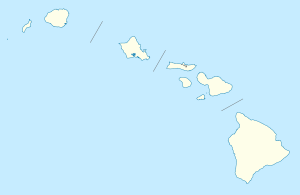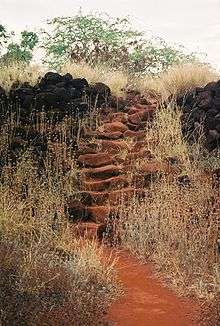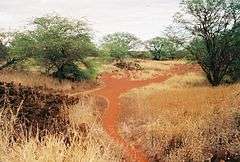Russian Fort Elizabeth
|
Russian Fort | |
|
Fort Elizabeth | |
 | |
| Nearest city | Waimea, Kauai County, Hawaii |
|---|---|
| Coordinates | 21°57′6″N 159°39′51″W / 21.95167°N 159.66417°WCoordinates: 21°57′6″N 159°39′51″W / 21.95167°N 159.66417°W |
| Area | 17.5 acres (7.1 ha) |
| Built | 1817 |
| Architect | Dr. Georg Anton Schäffer |
| NRHP Reference # | 66000299[1] |
| Significant dates | |
| Added to NRHP | October 15, 1966 |
| Designated NHL | December 29, 1962[2] |
Russian Fort Elizabeth is a National Historic Landmark and is administered as the Russian Fort Elizabeth State Historical Park just southeast of present-day Waimea on the island of Kauaʻi in Hawaiʻi.[3] It is located at the site of the former Fort Elizabety (Russian: Форт Елизаветы), the last remaining Russian fort on the Hawaiian islands, built in the early 19th century by the Russian-American Company as the result of an alliance with High Chief Kaumualiʻi.[2] It was employed by the Kingdom of Hawaii in the 19th century under the name Fort Hipo (Hawaiian: Paʻulaʻula o Hipo).
History

In 1815, German physician Georg Anton Schäffer, an agent of the Russian-American Company, arrived in Hawaiʻi to retrieve goods seized by Kaumualiʻi, chief of Kauaʻi island.[4]:91–95 According to the Company instructions, Schäffer had to begin by establishing friendly relations with king Kamehameha I who had created a kingdom incorporating all the islands of Hawaiʻi and faced opposition from rebellious Kaumuali'i. Then, with or without Kamehameha's support, Schäffer had to recover the cost of lost merchandise from Kaumualiʻi.
| Part of a series on the |
| History of Hawaii |
|---|
 |
| Timeline |
| Modern-day Hawaii |
|
|
Schäffer's medical expertise gained Kamehameha's respect but he denied the Russians any assistance against Kaumualiʻi. Schäffer was followed by two company ships, the Otkrytie and the Il'mena. He then sailed to Kauaʻi on his own. To his surprise, Kaumualiʻi eagerly signed a "treaty" granting Russian Tsar Alexander I of Russia a protectorate over Kauaʻi. Kaumualiʻi convinced Schäffer that the Russians could just as easily capture the whole archipelago. Schäffer promised that Tsar Alexander would help him to break free of Kamehameha's rule. Officially, Kaumualiʻi had pledged allegiance to Kamehameha in 1810. Kaumualiʻi probably never intended to give up power over the island; he thought he might reclaim his own kingdom with the help of Russia. Kaumualiʻi allowed Schäffer to build a fort near Waimea, named Fort or Fortress Elizabeth (Russian: Елизаветинская крепость, Elizavetinskaya Krepost’) in honor of the Empress of Russia at the time, Louise of Baden. Two others – Fortress Alexander (крепость Александра, Krepost’ Aleksandra) and Fort Barclay-de-Tolly (форт Барклая-де-Толли, Fort Barklaya-de-Tolli) – were named for the reigning emperor Alexander and his marshal Barclay-de-Tolly and constructed near Hanalei on Kauaʻi.
Fort Elizabeth was constructed in 1817 on the east bank of the Waimea River overlooking Waimea Bay. This fort was built in the shape of an irregular octagon, about 300 feet (91 m) to 450 feet (140 m) across, with walls 20 feet (6.1 m) high. It housed a small Russian Orthodox chapel, Hawaiʻi's first Orthodox Christian church. Fort Alexander built on Hanalei Bay also housed a small Orthodox chapel. When it was discovered that Schäffer did not have the backing of the Tsar, he was forced to leave Kauaʻi in the fall of 1817. Captain Alexander Adams replaced the Russian flag with the new Kingdom of Hawaii flag some time before October 1817. Russian Fort Elizabeth eventually came under the control of Kamehameha supporters.[5]
In 1820, the guns fired in salute as Kaumualiʻi's son, Prince George "Prince" Kaumualiʻi (also known as Humehume) arrived on the ship Thaddeus, after guiding American missionaries back to his home. Humehume tried to stage a rebellion in 1824 by attacking the fort. It was used as a base to capture him and keep the kingdom unified. It was abandoned in 1853.[3]

Dismantling
The Kingdom of Hawaiʻi tasked Kauaʻi pioneer Valdemar Knudsen with the removal of armaments from the fort. Similar work was being done in that era across the kingdom with other forts being dismantled at Kailua-Kona, Lāhainā and along the waterfront at the old port of Honolulu. In a letter sent to Honolulu, Knudsen listed an inventory of the guns at the fort following a survey made in 1862. They included 60 flintlock muskets, 16 swords, 12 18-pound cannon, 26 4- and 6-pound cannon, 6 heavy guns and 24 little guns. During the decommissioning of the fort in 1864, while Knudsen was loading armaments and munitions for sale as scrap metal onto a schooner in Waimea Bay, one or two cannons fell into the murky waters of Waimea Bay.
Access
The fort is located at coordinates 21°57′6″N 159°39′51″W / 21.95167°N 159.66417°W, on the southeastern shore of the mouth of the Waimea River in Waimea, Kauai County, Hawaii. A small parking lot is south of the Hawaii Route 50 bridge, known as Kaumualiʻi Highway in honor of the last king. Facilities at the park include an interpretive walking path, and restrooms. A brochure with details of the site is available for a self-guided interpretive tour. Visitors to this site can enjoy exploring the remains of the fort, viewing scenery, photography and historical interpretation.[6]
See also
References
- ↑ National Park Service (2007-01-23). "National Register Information System". National Register of Historic Places. National Park Service.
- 1 2 "Russian Fort". National Historic Landmark summary listing. National Park Service. Retrieved 2008-07-04.
- 1 2 Benjamin Levy (August 1978), National Register of Historic Places/National Historic Landmark 1978 Update: Russian Fort (pdf), National Park Service, retrieved 2009-10-30
- ↑ Khlebnikov, K.T., 1973, Baranov, Chief Manager of the Russian Colonies in America, Kingston: The Limestone Press, ISBN 0919642500
- ↑ William DeWitt Alexander (1891). A brief history of the Hawaiian people. American Book Company. p. 162.
- ↑ "Russian Fort Elizabeth State Historical Park". official state park web site. Hawaii Department of Land and Natural Resources. Retrieved 2009-10-31.
Further reading
- Mills, Peter (2002). Hawaii's Russian Adventure – A New Look at Old History.
External links
- "Fort Elizabeth". Hawaiiweb site. Retrieved 2009-10-31.
- Holy Theotokos of Iveron Russian Orthodox Church of Hawaii
- "Russian Fort Elizabeth". Discover Kauai web site: West Side. Kauai Visitors Bureau. Retrieved 2009-10-31.
- "Fort Elizabeth". Discover Kauai web site: West Side. Virtual Fort Elizabeth project. Retrieved 2015-08-19.
